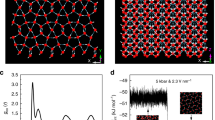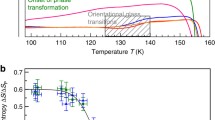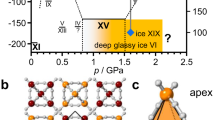Abstract
Water doped with 10−2 mol of KOH was cooled to temperatures at which most of the solution freezes to form hexagonal ice. Using proton and deuteron spin–lattice relaxometry as well as static field gradient diffusometry, it was found that a liquid-like phase coexists with the crystal down to below 200 K. The ionic dopants are expelled from the crystalline phase and form a KOH-enriched aqueous solution probably in the form of inclusions within the ice crystal. Its self-diffusion coefficient is only slightly smaller than that of nominally pure water. Motional correlation times were determined on the basis of spin–lattice relaxation times and compared with previous electrical conductivity and calorimetry results.






Similar content being viewed by others
Notes
This slight slow-down of the diffusion of the liquid-like component with respect to that of nominally pure water possibly arises from the hydration of the ions which are additionally present in the doped samples.
Obstruction effects arise if the space in which a particle can diffuse is partially blocked, as e.g., in porous media.
References
V.F. Petrenko, R.W. Whitworth, Physics of Ice (University Press, Oxford, 1999)
Y. Tajima, T. Matsuo, H. Suga, Phase transition in KOH doped hexagonal ice. Nature 299, 810 (1982)
S. Kawada, Dielectric Dispersion and Phase Transition of KOH Doped Ice. J. Phys. Soc. Jpn. 32, 1442 (1972)
Y. Tajima, T. Matsuo, H. Suga, Calorimetric study of phase transition in hexagonal ice doped with alkali hydroxides. J. Phys. Chem. Solids 45, 135 (1984)
M. Tyagi, S.S.N. Murthy, Dielectric Relaxation in Ice and Ice Clathrates and Its Connection to the Low-Temperature Phase Transition Induced by Alkali Hydroxides as Dopants. J. Phys. Chem. A 106, 5072 (2002)
R. Howe, R.W. Whitworth, The electrical conductivity of KOH-doped ice from 70 to 250 K. J. Phys. Chem. Solids 50, 963 (1989)
F. Fujara, S. Wefing, W.F. Kuhs, Direct observation of tetrahedral hydrogen jumps in ice 1 h. J. Chem. Phys. 88, 801 (1988)
R.J. Wittebort, M.G. Usha, D.J. Ruben, D.E. Wemmer, A. Pines, Observation of molecular reorientation in ice by proton and deuterium magnetic resonance. J. Am. Chem. Soc. 110, 5668 (1988)
B. Geil, T.M. Kirschgen, F. Fujara, Mechanism of proton transport in hexagonal ice. Phys. Rev. B 72, 014304 (2005)
A. Nowaczyk, H. Nelson, S. Schildmann, C. Gainaru, B. Geil, and R. Böhmer (in preparation).
M. Bach-Vergés, S.J. Kitchin, K.D.M. Harris, M. Zugic, C.A. Koh, Dynamic properties of the tetrahydrofuran clathrate hydrate, investigated by solid state 2H NMR spectroscopy. J. Phys. Chem. B 105, 2699 (2001)
T.M. Kirschgen, M.D. Zeidler, B. Geil, F. Fujara, A deuteron NMR study of the tetrahydrofuran clathrate hydrate. Part II: Coupling of rotational and translational dynamics of water. Phys. Chem. Chem. Phys. 5, 5247 (2003)
H. Nelson, A. Nowaczyk, C. Gainaru, S. Schildmann, B. Geil, R. Böhmer, Deuteron nuclear magnetic resonance and dielectric study of host and guest dynamics in KOH doped tetrahydrofuran clathrate hydrate. Phys. Rev. B 81, 224206 (2010)
O.B. Nasello, S. Navarro de Juarez, C.L. Di Prinzio, Measurement of self-diffusion on ice surface. Scripta Materialia 56, 1071 (2007)
Y. Furukawa, M. Yamamoto, T. Kuroda, Ellipsometric study of the transition layer on the surface of an ice crystal. J. Cryst. Growth 82, 665 (1987)
H. Dosh, A. Lied, J.H. Bilgram, Glancing-angle X-ray scattering studies of the premelting of ice surfaces. Surf. Sci. 327, 145 (1995)
S. Engemann, H. Reichert, H. Dosch, J. Bilgram, V. Honkimäki, A. Snigirev, Interfacial Melting of Ice in Contact with SiO2. Phys. Rev. Lett. 92, 205701 (2004)
Y. Mizuno, N. Hanafusa, Studies of surface-properties of ice using nuclear magnetic resonance. J. Phys. (Paris) Colloq. 48, 511 (1987)
T. Ishizaki, M. Maruyama, Y. Furukawa, J.G. Dash, Premelting of ice in porous silica glass. J. Cryst. Growth 163, 455 (1996)
F.E. Livingston, J.A. Smith, S.M. George, General trends for bulk diffusion in ice and surface diffusion on ice. J. Phys. Chem. A 106, 6309 (2002)
R. Cohen-Adad, M. Michaud, Les equilibres liquide-solide du systeme binaire eau-potasse. C. R. Acad. Sci. 242, 2569 (1956)
G. Vuillard, Vitrification des solutions aqueuses. Publ. Sci. Univ. Alger. B 3, 80 (1957)
P.P. Kobeko, E.V. Kuvshinski, N.J. Shishkin, Studies of the Amorphous State 10: a study of the conductivity of strong electrolytes in the amorphous state. Acta Physicochim. U.R.S.S. 6, 255 (1937)
A. Steinemann, Dielektrische Eigenschaften von Eiskristallen. II. Teil: Dielektrische Untersuchungen an Eiskristallen mit eingelagerten Fremdatomen. Helv. Phys. Acta 30, 581 (1957)
J.H. Bilgram, J. Roos, H. Gränicher, Spin-lattice relaxation in HF and NH3 doped ice and the outdiffusion of impurities. Z. Physik B 23, 1 (1976)
L. Vrbka, P. Jungwirth, Brine rejection from freezing salt solutions: a molecular dynamics study. Phys. Rev. Lett. 95, 148501 (2005)
J.G. Dash, A.W. Rempel, J.S. Wettlaufer, The physics of premelted ice. Rev. Mod. Phys. 78, 695 (2006)
B. Geil, Measurement of translational molecular diffusion using Ultrahigh magnetic field gradient NMR. Concepts Magn. Reson. 10, 299 (1998)
N. Bloembergen, E.M. Purcell, R.V. Pound, Relaxation effects in nuclear magnetic resonance absorption. Phys. Rev. 73, 679 (1948)
R. Böhmer, G. Diezemann, G. Hinze, E. Rössler, Dynamics of supercooled liquids and glassy solids. Prog. Nucl. Magn. Reson. Spectrosc. 39, 191 (2001)
H.R. Pruppacher, Self-diffusion coefficient of supercooled water. J. Chem. Phys. 56, 101 (1972)
K.T. Gillen, D.C. Douglass, M.J.R. Hoch, Self-diffusion in liquid water to −31 °C. J. Chem. Phys. 57, 5117 (1972)
R. Mills, Self-diffusion in normal and heavy water in the range 1–45 °C. J. Phys. Chem. 77, 685 (1973)
M. Holz, S.R. Heil, A. Sacco, Temperature dependent self-diffusion coefficients of water and six selected molecular liquids for calibration in accurate 1H NMR PFG measurements. Phys. Chem. Chem. Phys. 2, 4740 (2000)
T. Feiweier, B. Geil, E.M. Pospiech, F. Fujara, R. Winter, NMR study of translational and rotational dynamics in monoolein-water mesophases: Obstruction and hydration effects. Phys. Rev. E 62, 8182 (2000)
H. G. Hertz, Translational motions as studied by nuclear magnetic resonance, in Molecular Motion in Liquids, ed. by J. Lascombe (Reidel, Dordrecht, 1974) p. 337ff
C. Rønne, S.R. Keiding, Low frequency spectroscopy of liquid water using THz time domain spectroscopy. J. Mol. Liq. 101, 199 (2002)
R. Böhmer, K.L. Ngai, C.A. Angell, D.J. Plazek, Non-exponential relaxations in strong and fragile glass-formers. J. Chem. Phys. 99, 4201 (1993)
I.M. Hodge, C.A. Angell, Electrical relaxation in amorphous protonic conductors. J. Chem. Phys. 67, 4 (1977)
W.C. Hasz, C.T. Moynihan, P.A. Tick, Electrical relaxation in a CdF2–LiF–AlF3–PbF2 glass and melt. J. Non-Cryst Solids 172–174, 1363 (1994)
A. Pimenov, A. Loidl, R. Böhmer, Structural relaxation in a molten salt probed by time-dependent dc conductivity measurements. J. Non-Cryst. Solids 212, 89 (1997)
Z. Wojnarowska, C.M. Roland, K. Kolodziejczyk, A. Swiety-Pospiech, K. Grzybowska, M. Paluch, Quantifying the structural dynamics of pharmaceuticals in the glassy state. J. Phys. Chem. Lett. 3, 1238 (2012)
H. Didzoleit, C. Gainaru, R. Böhmer (in preparation)
M. Frey, H. Didzoleit, C. Gainaru, R. Böhmer (in preparation)
I.A. Ryzhkin, V.F. Petrenko, Violation of ice rules near the surface: A theory for the quasiliquid layer. Phys. Rev. B 65, 012205 (2001)
I.A. Ryzhkin, V.F. Petrenko, Quasi-liquid layer theory based on the bulk first order phase transition. JETP 108, 68 (2009)
C. Alba-Simionesco, B. Coasne, G. Dosseh, G. Dudziak, K.E. Gubbins, R. Radhakrishnan, M. Sliwinska-Bartkowiak, Effects of confinement on freezing and melting. J. Phys. Condens. Matter 18, R15 (2006)
J.B.W. Webber, J.C. Dore, J.H. Strange, R. Anderson, B. Tohidi, Plastic ice in confined geometry: the evidence from neutron diffraction and NMR relaxation. J. Phys. Condens. Matter 19, 415117 (2007)
C.A. Angell, Liquid fragility and the glass transition in water and aqueous solutions. Chem. Rev. 102, 262 (2002)
J.-M. Zanotti, M.-C. Bellissent-Funel, S.-H. Chen, Experimental evidence of a liquid–liquid transition in interfacial water. Europhys. Lett. 71, 91 (2005)
A. Geiger and D. Paschek, Properties of Water, in Wiley Encyclopedia of Chemical Biology (Wiley-VCH, Weinheim, 2008) pp. 1–9
C.A. Angell, Insights into phases of liquid water from study of its unusual glass-forming properties. Science 319, 582 (2008)
Acknowledgments
We thank Helge Nelson for interesting discussions. Support of this project by the Deutsche Forschungsgemeinschaft under grant no. BO1301/7 is gratefully acknowledged.
Author information
Authors and Affiliations
Corresponding author
Additional information
Dedicated to Prof. Dr. Hans Martin Vieth on the occasion of his 70th birthday.
Rights and permissions
About this article
Cite this article
Schildmann, S., Schöler, A., Nowaczyk, A. et al. Salty Water in KOH-Doped Hexagonal Ice: a Proton and Deuteron NMR Study. Appl Magn Reson 44, 203–215 (2013). https://doi.org/10.1007/s00723-012-0414-x
Received:
Revised:
Published:
Issue Date:
DOI: https://doi.org/10.1007/s00723-012-0414-x




